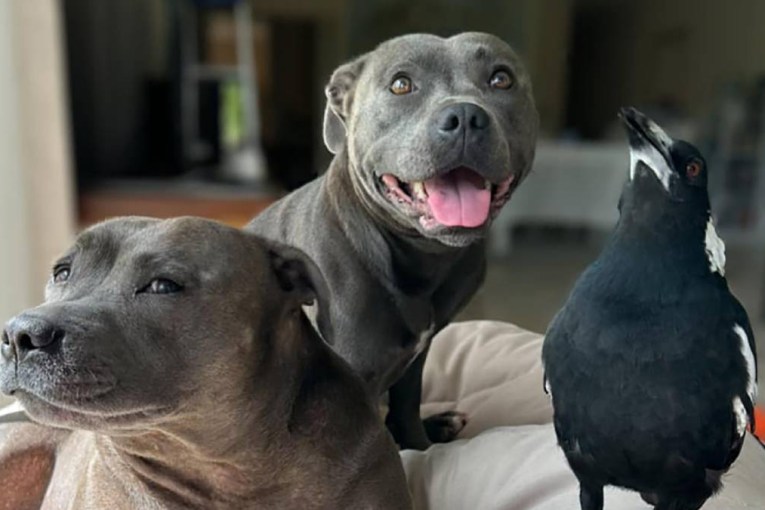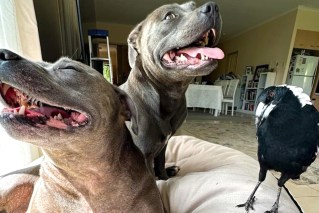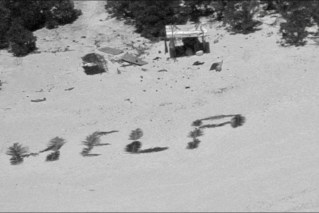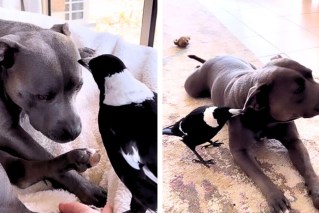For six years this orangutan was locked in a tiny cage, now he’s nearly free
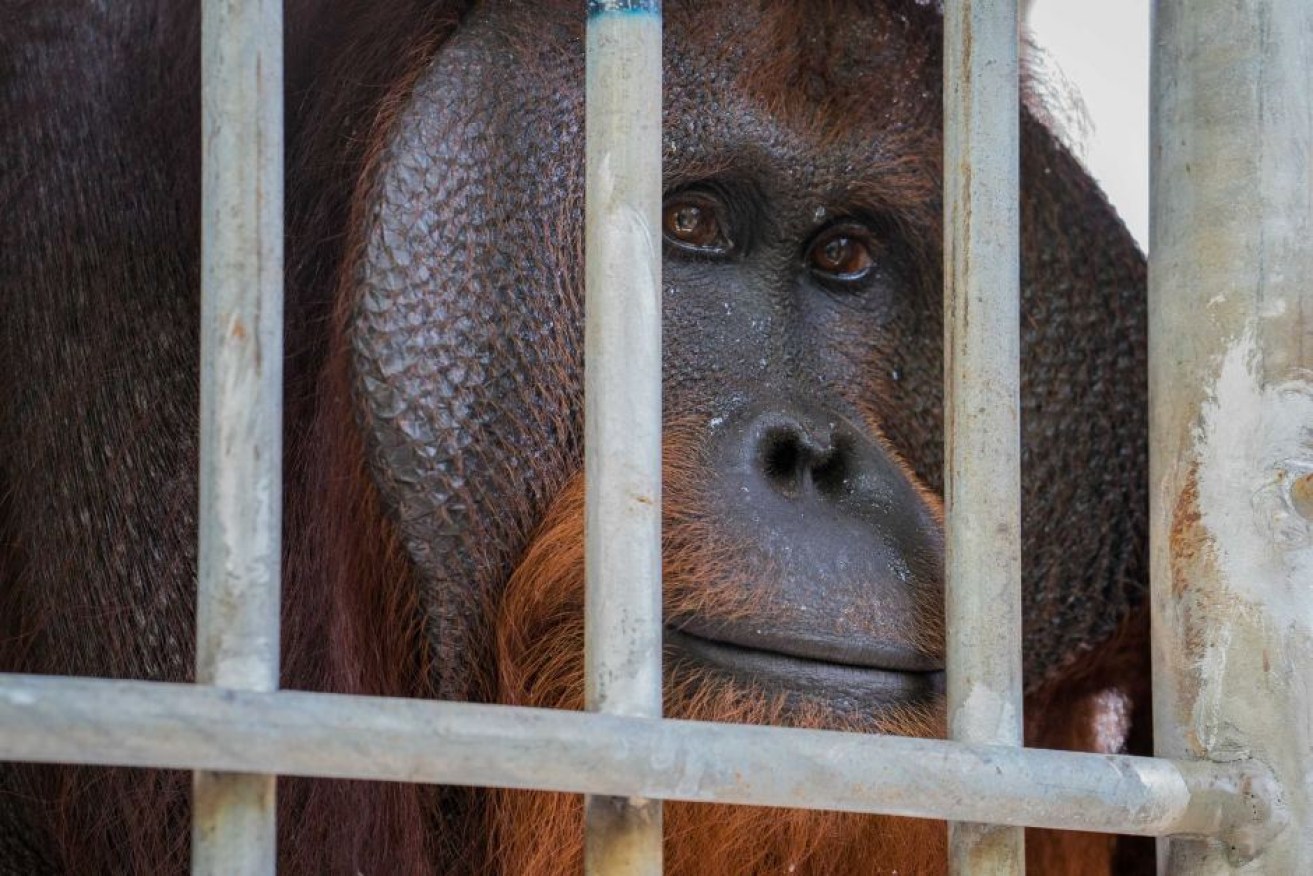
Close up of Jono in his new temporary cage at the Orangutan Foundation International. Photo: ABC
It’s 4am at an animal shelter deep in Jakarta’s suburbs, and a small team moves quickly through the night, following a tiny circle of light shone from a dimmed torch.
Our point man is armed with a metre-long length of pipe and a dart filled with two potent tranquilisers: ketamine and medetomidine.
Beside him is Nasum Ucup, a keeper at the shelter, which houses stolen and smuggled wildlife confiscated by government.
He guides us along a row of steel bars and stops at the final cage. The muted torchlight barely penetrates into the cage, but even in the low light you can tell that there’s something big inside.
No one speaks … or even whispers.
The dart man raises his blowpipe and then the silence of the rescue centre is torn apart by an ear-splitting screech.
It’s like a car alarm blasting a metre from your head.
It’s a cockatoo: another resident of the centre, alarmed to find half-a-dozen humans creeping through this place in the middle of the night.
The whole centre roars into life. The creature in the cage stirs, and stands up.
It’s Jono, an adult orangutan, and the reason we’re all here.
Biting the hand that feeds it
Jono’s been here, in this tiny cage, for six years, and it’s finally time for him to get out.
Jono, unsurprisingly, does not seem calm. Nasum tries to quieten him, patting his hand against the cage and calling, “Jono, Jono, Jono”, in a soft voice, trying to let him know that it’s him, Nasum, a familiar voice, giving the dart man time to get a clean shot.
Getting Jono out of the cage without being tranquilised is unthinkable — he’s eight times stronger than any of us and he could tear off an arm or a leg without much trouble at all.
Nasum’s still tapping the cage and the cockatoo is still screeching. Before I understand what I’m seeing a black hand shoots out and grabs Nasum’s wrist – and pulls his hand into the cage.
Jono bites Nasum, hard, and his hand is still in the cage.
The dart man and another keeper dive in and try to pull Nasum’s hand free.
After a few seconds Jono releases Nasum, who’s a bit shocked but his finger seems intact.
A dart is finally blown in to him, and within a few minutes Jono is knocked out.
He’s hauled out of the cage and carried inside for inspection.
Femke den Haas from the Jakarta Animal Aid Network says he’s in pretty good condition.
“This is the first time we’ve been able to inspect him thoroughly,” she says, as a team weighs and measures the unconscious Jono.
He’s then loaded into a custom-made crate ready for the flight to Pangkalan Bun.
‘No animal should stay here more for more than a few months’

Jono the orangutan in his cage in Jakarta. Photo: Foreign Correspondent
This mission has been planned for months. Animal welfare volunteers and Indonesian government officials had been working to get Jono out since last year when Jono’s presence at the centre was revealed by the ABC’s Foreign Correspondent program.
Femke den Haas says she didn’t know Jono was still in the centre.
“This transit centre is very important – it’s where they put wildlife that’s smuggled through the airport,” she tells 7.30.
“But it’s a transit centre.
“No animal should stay here for more than a few months.”
Jono was brought to the centre six years ago after he was confiscated from a private owner who’d kept him illegally as a pet. Efforts to find him a permanent home failed.

A wet young orangutan sitting in undergrowth at the Orangutan Foundation International. Photo: ABC
Ms den Haas says events moved quickly after the Foreign Correspondent episode. The Indonesian government agreed to grant permission for Jono to be moved.
DNA tests revealed Jono was from the Indonesian province of Kalimantan.
An orangutan rehabilitation centre in Kalimantan agreed to take Jono and donations from Australia helped cover the cost of a new, temporary cage at the Orangutan Foundation International centre outside the city of Pangkalan Bun, run by Professor Birute Galdikas.
The centre has released more than 500 orangutans back into the wild.
Often the centre is working with baby orangutans that are orphaned by fire or land clearing.

Staff at the Orangutan Foundation International training young orangutans. Photo: ABC
The young orangutans are raised by humans and taught survival skills in a jungle camp.
Getting an orangutan ready for release is a long process.
Professor Galdikas said Jono’s rehabilitation would take several years at least.
“We can’t just open the cage door and let him out into the forest,” she said.
“We have to make sure he knows how to make a nest. We also make sure that he’s capable of foraging, of finding wild foods in the forest.”
Initially he’ll go into a quarantine cage, then into a small reserve.
But the first step is getting him to Kalimantan.
Last stop before freedom
The most moving parts of the program come when Jono’s finally released into his new, temporary cage.
It’s four times bigger than his Jakarta cage, and it’s fitted with ropes and tyres for him to climb. It’s open to the light, and for the first time in at least six years, Jono’s able to swing and hang from the ceiling.
It’s a vast improvement.
Ms den Haas is in tears as Jono enters his new cage and immediately grabs hold of the ropes, swinging about the cage.
“For all these years he’s not been able to swing around,” she says.
“In the cage in the transit centre in Jakarta, there was nothing for him to swing with. He was always lying on a bare concrete floor.
“That was his life. Dark, no sunlight. Now he can finally swing again.”

Jono’s new temporary cage until he is released in to the wild. Photo: ABC
It is the last stop for Jono. After a short time in his new quarantine cage he will be released into the jungle.
Nasum Ucup, the keeper bitten by Jono, also made the trip to Kalimantan with Jono.
“I took care of Jono since he arrived in 2012 until today,” he says.
“I am very sad but he must return to his habitat.
“I am happy too, not just sad.
“I’m also proud. Maybe he bit me in that last moment so that he could remember me.”
Before leaving, Nasum gives Jono a final wave.
“Bye, Jono. Please remember me,” he says.
